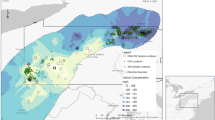Abstract
Sodic bentonite is widely used for industrial and scientific purposes, especially as a sealing agent1, because of its great ability to swell in water2,3. It has been proposed for use in high-level nuclear waste repositories as an impermeable barrier surrounding the waste package, or to fill tunnels, shafts and rooms. In some repositories, such as those planned in basalt, bentonite would be expected to be subjected to temperatures possibly up to 300 °C (refs 4, 5). As the waste would be approximately 600–900 m below the water table in fractured rock, the repository is expected to fill first with steam and then with liquid water4,6. Reaction of bentonite with liquid water produces a minimal loss of swelling capacity, but I show here that reaction with water vapour at 150–250 °C results in rapid irreversible loss of most of the swelling capacity. This causes very large increases in permeability of sand–bentonite mixtures7, thereby reducing the ability of a bentonite barrier to retard the flow of groundwater in proposed high-level nuclear waste repositories.
This is a preview of subscription content, access via your institution
Access options
Subscribe to this journal
Receive 51 print issues and online access
$199.00 per year
only $3.90 per issue
Buy this article
- Purchase on Springer Link
- Instant access to full article PDF
Prices may be subject to local taxes which are calculated during checkout
Similar content being viewed by others
References
Grim, R. E. & Güven, N. Bentonites: Geology, Mineralogy, Properties and Uses (Elsevier, Amsterdam, 1978).
Norrish, K. Discuss. Faraday Soc. 18, 120–134 (1954).
Low, P. F. & Margheim, J. F. Soil Sci. Soc. Am. J. 43, 473–481 (1979).
Staff, Basalt Waste Isolation Project Site Characterization Report for the Basalt Waste Isolation Project (Rockwell Hanford Operations, Richland, WA, DOE/RL-82-3, 1982).
Allen, C. D., Lane, D. L., Palmer, R. A. & Johnston, R. G. in Scientific Basis for Nuclear Waste Management VII, Mater. Res. Soc. Symp. Proc. Vol. 26 (ed. McVay, G. L.) 105–112 (North-Holland, New York 1984).
Couture, R. & Seitz, M. in NRC Nuclear Waste Geochemistry '83 (US Nuclear Regulatory Commission, Washington, DC, NUREG/CP-0052, 1984).
Couture, R. in Scientific Basis for Nuclear Waste Management VIII (eds Jantzen, C. M., Stone, J. A. & Ewing, R. C.) 515–522 (Materials Research Society, Pittsburg, 1985).
Weaver, C. E. Geothermal Alteration of Clay Minerals and Shales: Diagenesis (ONWI-21, Office of Nuclear Waste Isolation, Battelle Memorial Institute, Columbus, 1979).
Anderson, D. M. (ed.) Proc. Coll. St. Univ. New York at Buffalo (Svensk Kaernbraenslefoer-soernjing, Kaernbraenslesaekerhet, Stockholm, SKBF/KBS-83–03, 1983).
Peacor, D. R., Essene, E. J., Lee, J. & Kuo, L. in NRC Nuclear Waste Geochemistry '83 (US Nuclear Regulatory Commission, Washington, DC, NUREG/CP-0052, 1984).
Pusch, R. Stability of Deep-Sited Smectite Minerals in Crystalline Rock—Chemical Aspects (Svensk Kaernbraenslefoersoerjning AB, Stockholm, SKBF-KBS-83–16, 1983).
Grim, R. E. Clay Mineralogy 2nd edn (McGraw-Hill, New York, 1968).
Bradley, D. J., Coles, D. G., Hodges, F. N., McVay, G. L. & Westerman, R. E. Nuclear Waste Package Materials Testing Report, Basaltic and Tuffaceous Environments (Battelle Pacific Northwest Laboratory, Richland, Washington, PNL-4452, 1983).
Krumhansl, J. L. Observations Regarding the Stability of Bentonite Backfill in a High-level Waste Repository in Rock Salt (Sandia National Laboratories, Albuquerque, SAND-83-1293 J, 1983).
Couture, R. A. in Fuel Cycle Programs Quarterly Progress Report, Jan-Mar 1983 (Argonne National Laboratory, Argonne, ANL-83-68, 1984).
Barrer, R. M. Zeolites and Clay Minerals as Sorbents and Molecular Sieves (Academic, London, 1978).
Neal, C. Clays Clay Mineral. 25, 253–258 (1977).
Brown, G. The X-Ray Identification and Crystal Structures of Clay Minerals (Mineralogical Society, London, 1961).
Author information
Authors and Affiliations
Rights and permissions
About this article
Cite this article
Couture, R. Steam rapidly reduces the swelling capacity of bentonite. Nature 318, 50–52 (1985). https://doi.org/10.1038/318050a0
Received:
Accepted:
Published:
Issue Date:
DOI: https://doi.org/10.1038/318050a0
This article is cited by
-
Effect of hydrothermal path on swelling pressure and hydraulic conductivity of compacted bentonite
Bulletin of Engineering Geology and the Environment (2022)
-
Combined effects of temperature and salt solution on swelling of GMZ01 bentonite–sand mixtures
Bulletin of Engineering Geology and the Environment (2021)
Comments
By submitting a comment you agree to abide by our Terms and Community Guidelines. If you find something abusive or that does not comply with our terms or guidelines please flag it as inappropriate.



